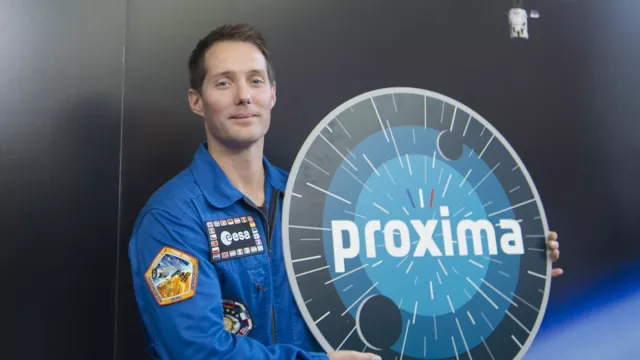17 November 2016, a Soyuz launcher lofted an international crew into space from the Baikonur Cosmodrome on a six-month mission to the International Space Station. Thomas Pesquet, flight engineer in the Soyuz spacecraft, was embarking on the Proxima mission during which he would conduct numerous science and education activities aboard the station.
Key information
Key figures
- 62 scientific experiments coordinated by ESA and conducted by Thomas on the ISS, 7 developed specifically by CNES
- 500,000 youngsters on Earth who took part in educational experiments initiated by Thomas Pesquet throughout his mission
- 5 space agencies involved in this ISS mission: ESA (Europe), NASA (United States), JAXA (Japan), Roscosmos (Russia) and CSA (Canada)
- 3 extravehicular activities
Key milestones
- 2 June 2017: Landing back on Earth at 16:10 CET in Soyuz spacecraft
- 2 June 2017: Soyuz spacecraft undocks from ISS at 12:47 CET
- 24 March 2017: 2nd extravehicular activity
- 13 January 2017: 1st extravehicular activity
- 19 November 2016: Soyuz docks to ISS at 22:58 CET
- 17 November 2016: Soyuz lifts off at 21:20 CET
Project in brief
The name of the Proxima mission was picked from more than 1,300 entries in a competition organized by the European Space Agency (ESA) in 2015.
It references Proxima Centauri, the closest star to our Sun and also the parent star of the closest known exoplanet. But it also recalls the relative proximity of the International Space Station (ISS) that hosted the mission, orbiting at an altitude of just 400 kilometres. And it evokes the fact that many of the discoveries and technological advances made on the station find applications in our daily lives down here on Earth.
In Thomas Pesquet’s own words: “We don’t go into space for purely selfish reasons, but because we believe it’s useful for everyone on Earth. It’s a collective adventure, born out of the dreams and sheer hard work of a multitude of people. That’s why I really want to share my experience with the widest number.”
Maintaining a permanent crew on the ISS requires careful planning. Every three months or so, three astronauts are “rotated out” and replaced by a new trio. These crew rotations are termed “expeditions” by NASA. Each astronaut stays for about six months, completing the last three months of an expedition and starting the first three of the next one.
For Proxima, Thomas Pesquet was part of Expeditions 50 and 51. He flew to the station aboard a Soyuz MS-03 spacecraft as flight engineer alongside Russian Soyuz commander Oleg Novitsky and NASA astronaut Peggy Whitson.
Proxima marked the grand return of a French astronaut to the ISS eight years after Léopold Eyharts, who worked on installing the Columbus module where Thomas Pesquet performed many of his scientific experiments.
Thomas in fact contributed to 62 experiments coordinated by ESA and CNES, designed to advance knowledge across a diverse range of fields including how the human brain works, ocean currents, space radiation and the behaviour of atoms. Europe’s astronaut also tested new spacecraft materials and new technologies aboard the station.
Like previous French missions on Russia’s Mir space station and the ISS, the focus was on human physiology, with scientists looking to learn more about cognitive and motor skills, bones and muscle health, with their sights on future space exploration missions.
But Thomas didn’t only work for European science on his Proxima mission. He also contributed to some 55 other experiments for the U.S., Canadian, Japanese and Russian space agencies.
As well as performing and monitoring all of these experiments, he also conducted two extravehicular activities to change out batteries, inspect a small leak in the station’s cooling system, take care of the Canadarm robotic arm, maintain the station and fit it out with new equipment.
CNES’s role
During his sojourn on the ISS, Thomas Pesquet conducted seven CNES-led projects, aiming chiefly to make life easier for its crew, improve monitoring of their health and advance scientific research:
PERSPECTIVES: Test of a virtual-reality headset designed for future experiments analysing how the brain adapts to microgravity.
Partners: CNRS, Paris Descartes University, INSERM, Virtual-IT, Oculus, MEDES, Comat, Codamotion Charnwood Dynamics, Tecnalia
Fluidics: this experiment took the form of three spheres containing fluids and subjected to rotation or vibration inside a centrifuge at varying levels of gravity to better understand how liquid propellants behave in satellites.
Partners: Airbus Defence & Space, ENS Ulm, Paris 7 University
Aquapad: a device for quick and effective testing of water potability and urine or blood testing by injection into a sealed capsule of reactants to identify germs and bacteria.
Partners: MEDES, NASA, Biomérieux
EveryWear: fast and easy acquisition of astronaut health data from wearable connected sensing devices.
Partners: MEDES, INSERM, ESA-EAC, Bodycap, Cityzen Science, ESIEE Paris, Caen University, Paris Descartes Faculty of Medicine
MATISS: innovative ‘smart’ surfaces preventing bacteria from gaining hold and proliferating, placed in areas exposed to strong contamination and later brought back to Earth for analysis.
Partners: ENS Lyon, CNRS, CEA Tech-LETI, Saint Gobain
ECHO: an ultrasound scanner with motorized heads operated remotely from Earth.
Partners: Tours University Hospital, ESA, CSA, EREMS, Sonoscanner, Vermon, Teamviewer, Optimalog, Airbus
EXO-ISS: Educational experiments designed to give schools the opportunity to work on space topics: CERES to study seed growth, CRISSTAL to examine crystal growth in microgravity and CATALISS to look at how microgravity influences enzyme reactions.
Contacts
Proxima mission Project Leader
Sébastien Barde
E-mail: sebastien.barde at cnes.fr


